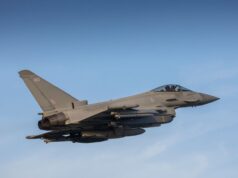The Royal Navy said its Wildcat HMA2 helicopters and the Martlet lightweight multirole missile successfully engaged a variety of uncrewed aerial and surface targets during Exercise Wildfire, a four-day French-led maritime exercise held from 29 September to 2 October, the Royal Navy stated.
The exercise paired the French strike group, including destroyers Forbin and Lorraine and Rafale aircraft, with the Royal Navy’s Wildcat Maritime Force from 815 Naval Air Squadron to run air-defence serials against challenging target sets, according to the Royal Navy.
Trials followed earlier live firings at Aberporth in Wales and a demanding sequence of engagements off the French Mediterranean coast near Hyères.
The Royal Navy said the Wildcat detected and engaged small fast fixed wing UAS and surface targets. In a highlighted engagement, a Wildcat launched a Martlet to intercept an Alba small UAS, destroying the target and protecting the French destroyers on the range. The service added that the Martlet has now been declared fully operational following the autumn test programme and that Sea Venom, the heavier anti-ship missile for Wildcat, recently reached initial operating capability.
Lieutenant Commander Rhydian Edwards, Officer in Command of the Operational Advantage Group Wildcat Maritime Force and resident experimental test pilot, described the difficulty of the aerial target, saying in the Royal Navy news update:
“Destroying the Albas was like trying to kill a fly with a laser-guided dart.” He later told colleagues the trials had produced data that would “greatly increase our understanding of the Wildcat’s weapon systems, allowing us to ensure that they can be employed to maximum lethality as demonstrated against air and surface targets alongside our UK and international partners on Exercise Wildfire.”
The Royal Navy said hundreds of Martlet rounds were delivered to Ukraine under a UK gifting programme and that an export deal will see missiles supplied to India, with UK employment benefits cited by the service. The release described Martlet as capable of accelerating to roughly one and a half times the speed of sound during flight, a performance detail stated by the Royal Navy.
Minister for Defence Readiness and Industry Luke Pollard was quoted in the update as saying the missile “represents another significant leap forward in our capabilities and by supporting hundreds of UK jobs, shows how defence is an engine for growth while making Britain safer”.
Commander Andrew Henderson, commanding officer of the Wildcat Maritime Force, summed up the trials as a chance to validate tactics and hardware against realistic threats, saying “testing and validating our aircraft against realistic targets in challenging environments ensure that we capture vital data.”















Marlett could have been essentially tailor made for a future drone infested littoral, with the wildcat able to carry 20 missiles it really is a great combination against swarm attacks by drones. It’s a shame the T26 cannot take a wildcat and merlin easily at the same time.
Ukraine?
Is a land-based launcher available for Martlet? It would be good in Ukraine.
It’s already in use in Ukraine, having been integrated with the Stormer air defence vehicles we sent them a while back. There’s also a shoulder-launched variant in service in Ukraine. Reportedly they like it, but it’s nothing special. Good for drones, but Starstreak does a better job against the helicopters.
Yes its the same lauchers at starstreak iirc
I wonder if Starstreak could also fit in the Martlet launchers?
Helicopter launched Starstreak would be great fun.
It might take some software updates and testing, but there’s no fundamental issues with it, they both use the same guidance system.
Yes there was film first released about a year+ ago of a shoulder launched Martlet bringing down a drone in Ukraine when no official delivery had been admitted. Interchangeable with Starstreak on launchers and somewhat easier to use (if less lethal as you say) from shoulder launched versions which u like the Stormer version needs a fair amount of training. So Martlet is a very good option for lesser targets and still effective beyond that it seems.
I’m surprised they have not looked at this before, wild cat with its high speed for helicopter and ability to operate at low levels seems ideal.
Wildcat is not as fast as Lynx though and when you consider the various top speeds of the Worlds Helicoptors, there is a rather small speed advantage.
Wildcat maybe 230mph, S60 @ 190mph, Chinook @ 200mph, Special one off Lynx 249mph in record attempt.
It’s the Rotors that are the issue with going faster (although Airwolf could out run F16’s).
#stringfellowhawk
Good point, seems like a good speed though for chasing propellor powered drones especially when you have a Mach 4 guided missile and you can claim to a medium altitude.
I don’t think HVM has been helicopter fired yet, there was some talk mid 2000s of using it from Apache but it was never part of the discussion for Wildcat.
A pity IMO, along with the abandonment of SeaStreak. HVM is a very, very cool missile.
Jim, I really rate this capability, especially mated to a Wildcat, I’m sure it would be a usefull thing in any conflict.
Agree
Can the Martlet launch system be fitted to the Rivers? Or an adapted version of it? Or for that matter, any other ship in the RFA / RN that is basically very lightly armed? I know sweet b…er all about this but any system that could fulfil a dual or triple purpose is definitely an advantage?
I believe it was trialled as an add on launcher on the 30mms gun mount but there was significant blow back of post launch debris.
I read somewhere that the door to the 30mm magazine is located right behind the gun mount on the T23, which was a major safety issue. Not sure if that is true, but would seem to be a valid concern
Why couldn’t they move/relocate the magazine? Mentioned this on a previous post, employ angled exhaust pipes or as others have said before, use enclosed cannisters. Maybe MSI, Moog and Thales need to get together to sort the mount issue out. It would be a good combo weapon station to have especially for smaller opvs and RFAs.
Ship magazines are normally integral to the design and can’t be moved.
Somtimes
Just reading all these Article headlines would create dangerous thoughts if one didn’t read further.
“American Warships open fire in the Med”.
“Russian Submarine surfaces off French Coast”
“Freddie Star ate my Hamster”.
Hamster? You got off lightly. The bugger ate two of my guinea pigs.
Ah, there’s more meat on a GP though.
A chap called Elvis deep fries them in batter down our local chippy.
“thank you very much”.
How about buying Martlet for Wildcat AH1s of the AAC so that they have something other than a machine gun in the door?
Yes Deffo.
And lets order B3 Rivers with a Wildcat sized hanger, a real force multiplier and blue water presence.
5 for the cost of a T26 ?
I’d go for it. I know many here wouldn’t.
I just see the B2’s are doing great work all over our areas of interest, giving presence and experience to crews unlike pretty much everything else (we have left now) which is either in dock being repaired or about to be.
Would a B3 River with a hanger basically be a whole new ship? I’d be interested to know what a stripped down, patrol ship spec Type 31 would cost, with a smaller radar and gun only armament. Maybe replace the 57mm with another 40mm so that there is no deck penetrating ammunition handling system to reduce manpower and damage control limitations.
It would be a bigger ship of course, but steel is cheap and it’s the systems that add cost and manpower requirements.
We’re still waiting on the long promised radar and data link.
I think that’ll go on longer. I’m still waiting for the 22 Chinooks Gareth Ainsworth VOWED in 2007 as the carrot for losing Harriers and RAF Cottesemore.
I’m also waiting for Austute 8 and T45 7 and 8, also vowed as the carrot of previous cuts….
TLDR.
I trust nothing these mouthpieces and talking heads say or propose.
We await the defence industry plan and the NMH procurement plan. Could the AW149s go to the AAC?
I’ve read of the idea. I don’t know.
5 AAC predictably lost all its aircraft and has now left Aldergrove.
RAF Benson is sitting pretty empty as 33 and 230 Sqns have gone.
Maybe the Stars align and Benson goes to the Army, with 5 Reg there.
Maybe 33 or 230 Reform.
Maybe Pigs might fly.
Maybe HMG will actually BUY something and stop talking.
We could be here a while…
Sea venom was actually originally declared to have achieved IOC on 2021 …. two parties 4 years apart for the same milestone
A premature ejaculation, it seems.